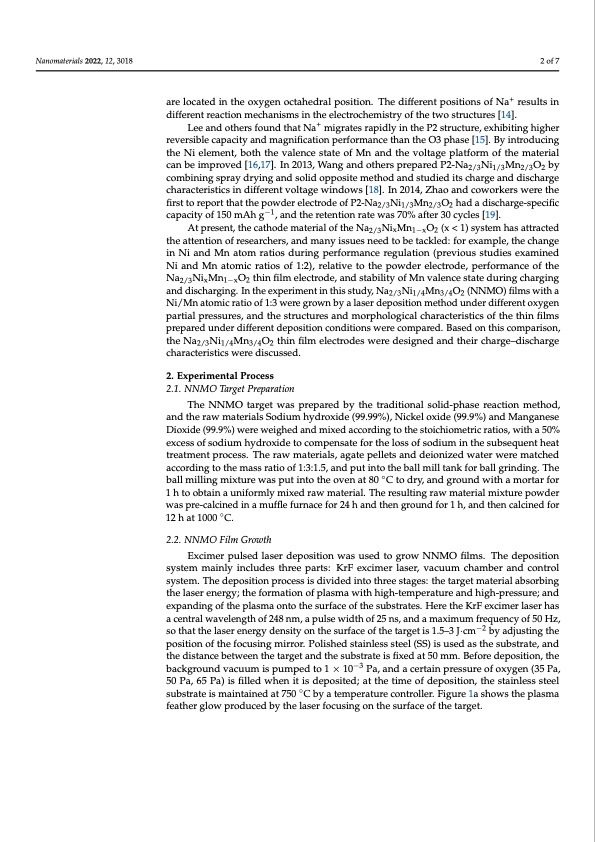
PDF Publication Title:
Text from PDF Page: 002
Nanomaterials 2022, 12, 3018 2 of 7 are located in the oxygen octahedral position. The different positions of Na+ results in different reaction mechanisms in the electrochemistry of the two structures [14]. Lee and others found that Na+ migrates rapidly in the P2 structure, exhibiting higher reversible capacity and magnification performance than the O3 phase [15]. By introducing the Ni element, both the valence state of Mn and the voltage platform of the material can be improved [16,17]. In 2013, Wang and others prepared P2-Na2/3Ni1/3Mn2/3O2 by combining spray drying and solid opposite method and studied its charge and discharge characteristics in different voltage windows [18]. In 2014, Zhao and coworkers were the first to report that the powder electrode of P2-Na2/3Ni1/3Mn2/3O2 had a discharge-specific capacity of 150 mAh g−1, and the retention rate was 70% after 30 cycles [19]. At present, the cathode material of the Na2/3NixMn1−xO2 (x < 1) system has attracted the attention of researchers, and many issues need to be tackled: for example, the change in Ni and Mn atom ratios during performance regulation (previous studies examined Ni and Mn atomic ratios of 1:2), relative to the powder electrode, performance of the Na2/3NixMn1−xO2 thin film electrode, and stability of Mn valence state during charging and discharging. In the experiment in this study, Na2/3Ni1/4Mn3/4O2 (NNMO) films with a Ni/Mn atomic ratio of 1:3 were grown by a laser deposition method under different oxygen partial pressures, and the structures and morphological characteristics of the thin films prepared under different deposition conditions were compared. Based on this comparison, the Na2/3Ni1/4Mn3/4O2 thin film electrodes were designed and their charge–discharge characteristics were discussed. 2. Experimental Process 2.1. NNMO Target Preparation The NNMO target was prepared by the traditional solid-phase reaction method, and the raw materials Sodium hydroxide (99.99%), Nickel oxide (99.9%) and Manganese Dioxide (99.9%) were weighed and mixed according to the stoichiometric ratios, with a 50% excess of sodium hydroxide to compensate for the loss of sodium in the subsequent heat treatment process. The raw materials, agate pellets and deionized water were matched according to the mass ratio of 1:3:1.5, and put into the ball mill tank for ball grinding. The ball milling mixture was put into the oven at 80 ◦C to dry, and ground with a mortar for 1 h to obtain a uniformly mixed raw material. The resulting raw material mixture powder was pre-calcined in a muffle furnace for 24 h and then ground for 1 h, and then calcined for 12 h at 1000 ◦C. 2.2. NNMO Film Growth Excimer pulsed laser deposition was used to grow NNMO films. The deposition system mainly includes three parts: KrF excimer laser, vacuum chamber and control system. The deposition process is divided into three stages: the target material absorbing the laser energy; the formation of plasma with high-temperature and high-pressure; and expanding of the plasma onto the surface of the substrates. Here the KrF excimer laser has a central wavelength of 248 nm, a pulse width of 25 ns, and a maximum frequency of 50 Hz, so that the laser energy density on the surface of the target is 1.5–3 J·cm−2 by adjusting the position of the focusing mirror. Polished stainless steel (SS) is used as the substrate, and the distance between the target and the substrate is fixed at 50 mm. Before deposition, the background vacuum is pumped to 1 × 10−3 Pa, and a certain pressure of oxygen (35 Pa, 50 Pa, 65 Pa) is filled when it is deposited; at the time of deposition, the stainless steel substrate is maintained at 750 ◦C by a temperature controller. Figure 1a shows the plasma feather glow produced by the laser focusing on the surface of the target.PDF Image | xcimer Laser-Deposited Na Film Cathode Sodium-Ion Battery

PDF Search Title:
xcimer Laser-Deposited Na Film Cathode Sodium-Ion BatteryOriginal File Name Searched:
nanomaterials-12-03018.pdfDIY PDF Search: Google It | Yahoo | Bing
Salgenx Redox Flow Battery Technology: Salt water flow battery technology with low cost and great energy density that can be used for power storage and thermal storage. Let us de-risk your production using our license. Our aqueous flow battery is less cost than Tesla Megapack and available faster. Redox flow battery. No membrane needed like with Vanadium, or Bromine. Salgenx flow battery
| CONTACT TEL: 608-238-6001 Email: greg@salgenx.com | RSS | AMP |